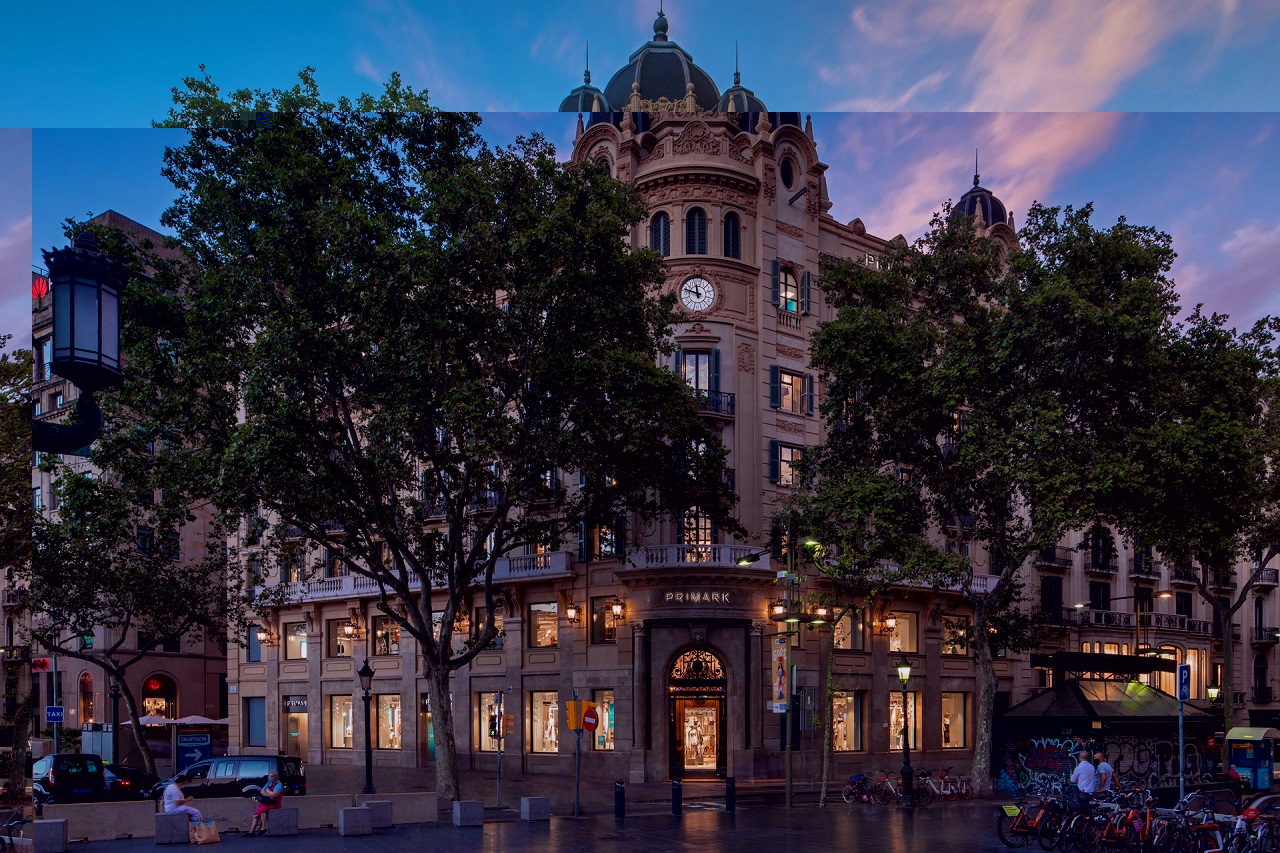Widd Signs has been creating stunning signage since 1888 and we’re proud to have worked on some of the world’s most iconic buildings.
In this blog we look at some of the most beautiful buildings we’re proud to have created and installed the signage for.
Primark
We’ve been the signage partner for Primark for almost 20 years, supporting the retailer with signage for many of its global stores. Here we turned to Europe to look at some of the most beautiful Primark store buildings:
Madrid

Primark retail signage produced by Widd Signs
The latest Primark store to open is in Madrid in the iconic former Cine Salamanca on Conde de Peñalver, which opened in May 2024.
Once a movie theatre during the 1930s golden age of cinema, today this beautiful building houses Primark’s 11th store in Madrid.
Located in the heart of the Salamanca district, the new store beautifully blends the latest fashion with a cinematic charm, paying homage to the building’s rich history.
Customers can enjoy an enchanting movie theatre aesthetic, featuring a restored entrance staircase, a dramatic sky roof foyer, rich red and gold design features, cinematic typography, dramatic lighting, and even a large digital cinema-style screen.
With 3,600 square meters of shopping space over five floors, our latest addition to Primark Spain represents a €15 million investment and the creation of over 200 jobs in the local community.
Barcelona
Primark’s multi-million-euro flagship Barcelona store sits at the heart of the famous Las Ramblas boulevard.
We designed and installed striking illuminated exterior and interior signage at the store over a seven-week period in 2020.
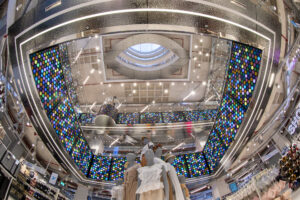
The project comprised of external Primark brand signage, as well as unique internal directional and departmental signage on each of the store’s five retail floors reflecting a Gaudi-esque design. Over 50 different acrylic and aluminium-made signs were installed in total, comprising of approximately 5,000 energy-saving LEDs and over 1km of wiring.
Prague
We put our digital and traditional signage skills forward to design, manufacture and install over 100 signs at the store – the retailer’s 396th and its first in the Czech Republic.
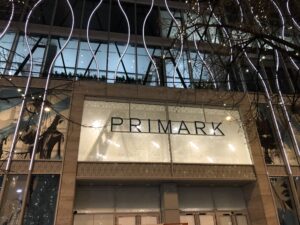
Primark Prague
The project comprised of illuminated external Primark branded signs measuring almost five meters in length, as well as unique internal directional and departmental signage on each of the store’s three floors.
Primark’s Wenceslas Square store is located in The Flow building, which was designed by the UK-based architectural firm Chapman Taylor.
Bilboa
We created an eye-catching lighting feature spanning five-storeys at Primark’s store in the Spanish city of Bilboa, as part of a five-figure project to transform the building.
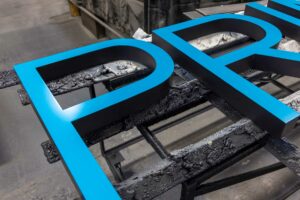 Designed, manufactured and installed by Widd Signs, the programmable lighting feature enables the retailer to display a dazzling array of colours and lighting patterns on the exterior of its five-storey outlet, which sits at the heart of the city on the main avenue known as the Gran Vía.
Designed, manufactured and installed by Widd Signs, the programmable lighting feature enables the retailer to display a dazzling array of colours and lighting patterns on the exterior of its five-storey outlet, which sits at the heart of the city on the main avenue known as the Gran Vía.
We created a colourful decorative effect on the windows of the store’s giant glass atrium, using optically coloured dichroic film.
As part of the project, we also designed, manufactured and installed hundreds of exterior and internal signs at the 4,550 sq meter store, most of which were written in both Spanish and Basque to reflect the two languages spoken in Bilboa. The bespoke signage comprised of external brand signage, as well as illuminated internal directional and departmental signage on each of the store’s five retail floors.
And it’s not just large retailers which boast some striking buildings
Spine Building, Liverpool
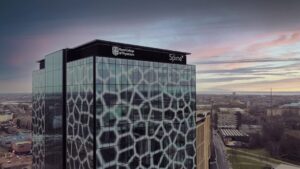
We partnered with main contractor, Morgan Sindall, to deliver the high-level external branding for The Spine building.
Situated in the heart of the Liverpool’s Paddington Village, the building recently also nicknamed by locals as “the giraffe” for this unique human skin cell pattern within the architectural glazing, home to the Northern Head Quarters for the Royal College of Physicians.
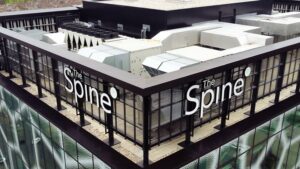
The Spine costing £35m is Liverpool’s highest point and we were delighted to have been given the responsibility to implement the branding which is now visible across the city.
Berry’s Jewellers
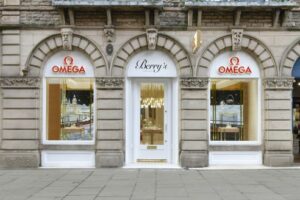
Berry’s Nottingham signage by Widd Signs
We’ve worked with Berry’s since the 1970s initially supporting the signage when it moved its high-quality retail store jewellers from its initial home on Bond Street, Leeds to its existing Albion Street, Leeds store.
We’re delighted to have provided the signage for Nottingham’s store which sits within a listed building.
We followed strict guidance to ensure both beauty and practicalities were accomplished. We did this by supplying and installing push-through acrylic letters on folded aluminium panels, formed to fit into the intricate architecture of the building on Bridlesmith Gate. Omega and Berry’s panels were also created in their iconic branding. As part of this project, we produced and installed a new flag and pole to emblazon the outside facade.
We have also carried out work at their Berry’s Nottingham store to rebrand their internal jewellery display showcases.
The trilogy of Berry’s York stores is based on the beautiful cobbled streets of Stonegate in the heart of the city and the council had strict requirements about the aesthetics matching the surrounding environment.
We supplied new hanging signage to replace and match the existing bracketry, working alongside traditional signwriter ‘Brian the Brush’ who created the handwritten signage for the shopfront of their #60 store, where the building has stood on that site since the 17th Century.
Stonebridge Beck, Farsley, Leeds
We are proud to have created the signage for a poignant large-scale public artwork at Stonebridge Beck at Farnley, Leeds.
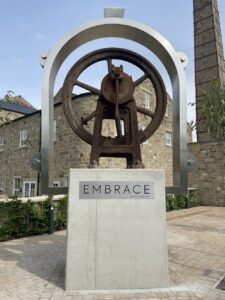
‘Embrace’ sign at Stonebridge Beck
Working with Rushbond, the brief was to create an information plaque showing the heritage of the mill – as some of the elements have been retained, and a name/title plaque to mark artwork ‘Embrace’ installed at the new housing development.
The magnificent spacious mill town housed in the sympathetically converted Grade 11 listed former mill sits seamlessly alongside former workers’ cottages. Our client wanted the feel of an exhibition piece with inspiration pulled from outdoor heritage information signage.
The signage we created was chemical-etched 2mm brushed stainless with black ink fill. Dimensions: 1300 x 700 & 1300 x 300.
The heritage plaque consists of textile workings from this site which date as far back as 1805.
At the time the mill was operated by woollen manufacturers Thomas Pawson and John Haley. Expansions took place between 1805 and 1819 and Stonebridge Mills spearheaded the local industrial offering becoming home to a fully integrated steam-powered woollen textile mill.
From 1828 Stonebridge Mills housed a boiler house, drying house, burling rooms, picking rooms, handle setting rooms, Willey House, three cottages, stable and wareshop, dye house raising room and joiners’ shop, wool warehouse, counting-house, picking rooms, hot pressing shop, hand spinning room, hand spinning and weaving shops and cloth warehouse.
From the 1870s further innovative advancements took place involving the construction of the new mill in its own independent engine house which powered the New Mill and various weaving sheds.
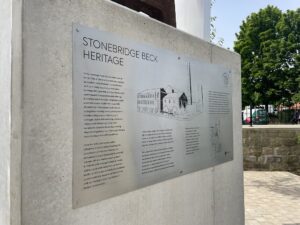
Stonebridge Beck heritage sign
In 1896 the Mills changed hands and were sold to Leeds cloth manufacturer Andrew Mellish. In 1902 a Gas Generator was installed as well as electric power to all floors of the Mills, reinforcing Stonebridge Mills as a hotbed for innovation.
Fred Armitage Lodge & Sons took over the site in 1931 but tragically saw the New Mill building go up in flames as fire took hold in 1936. It was since never rebuilt albeit the water tower still stood tall reaching for the attention of those who could give it new life.
The Lodge family were the last owners to undertake textile manufacturing on this site and the water tower was for a long time branded by the Lodge name. Textile manufacturing ceased in 1980 and since, adopted a new use as a trading estate with a mixture of businesses occupying the buildings which increasingly fell into disrepair unable to be properly used or enjoyed.
Stonebridge Mills, a much-loved Leeds landmark has been transformed to accommodate a new community anchored within a traditional context by regional heritage development experts, Rushbond PLC. The water tower celebrates a place steeped in history now wearing the badge Stonebridge Mills.
As part of the redevelopment, neglected industrial machinery was salvaged. To celebrate its heritage, a public sculpture was commissioned framing the entrance to the site. The work consists of a crucial part of historic machinery, the water pump wheel, framed by a large-scale piece of hand-crafted stainless steel positioned on a concrete plinth.
Titled ‘Embrace’ the work is meant to metaphorically embrace one home. Artist Chris Knight aims to represent the repurposing of the buildings and their recasting into another role more relevant to the needs of today and celebratory of life.

